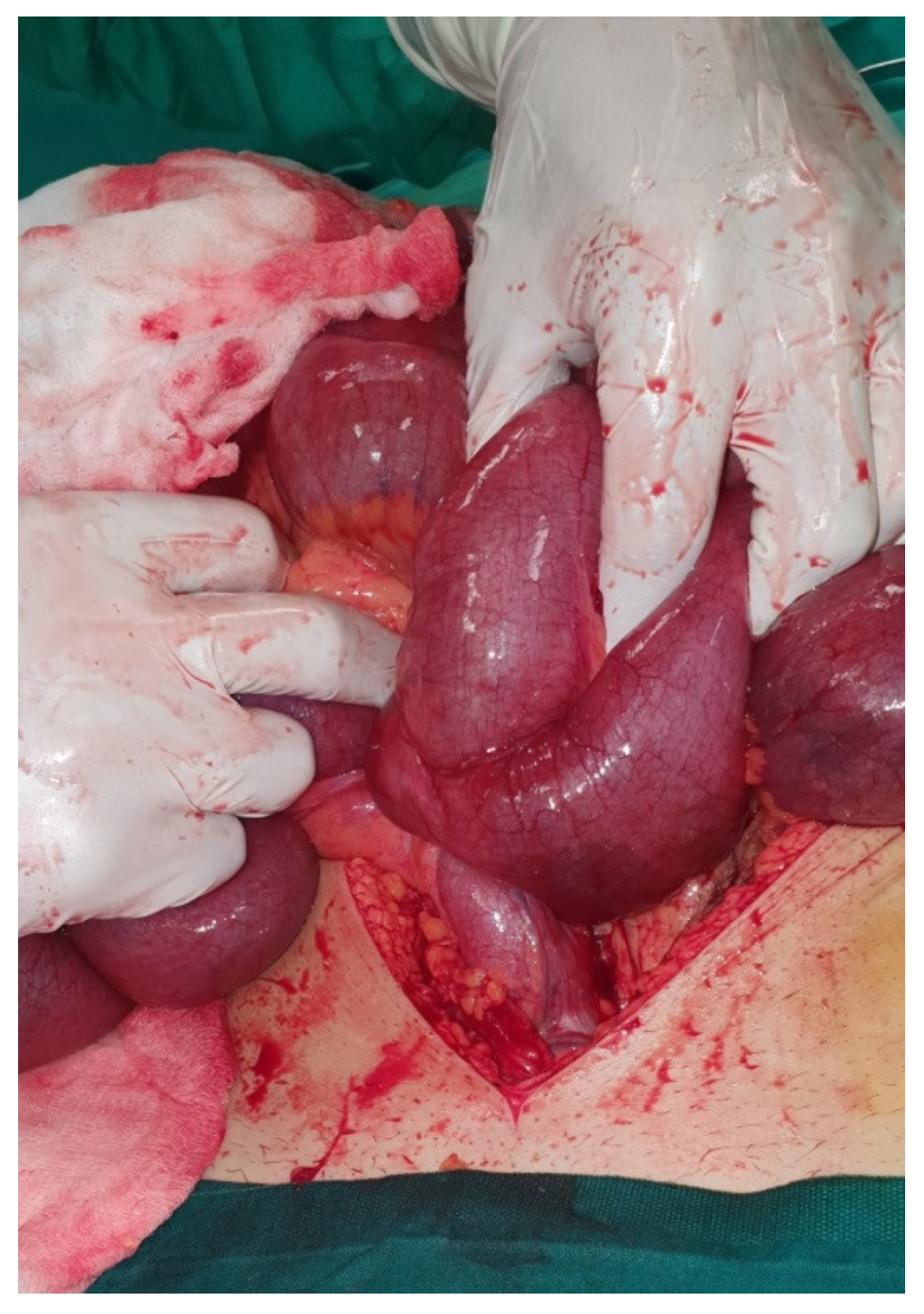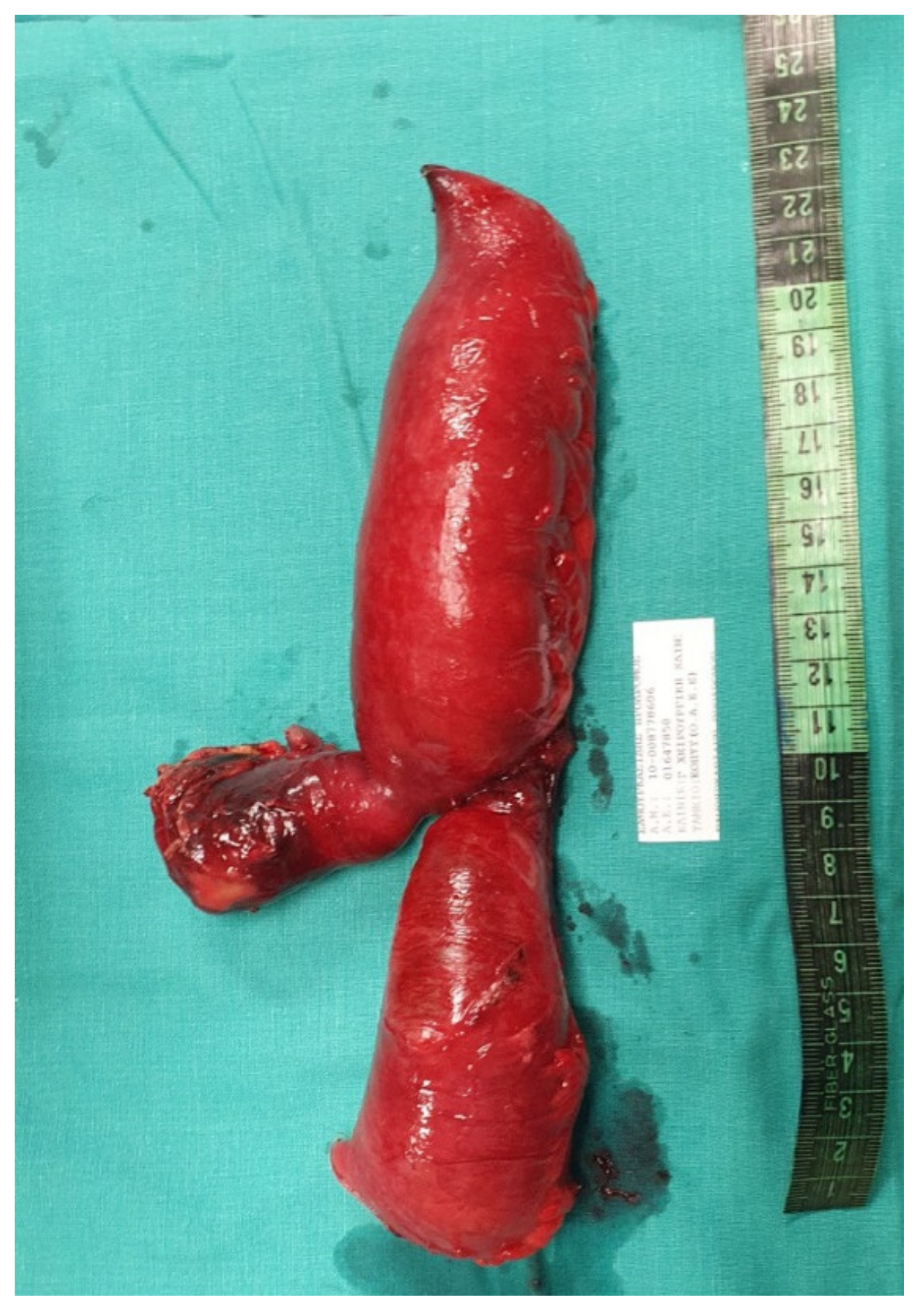Internal Hernia and Volvulus in an Adult Male Caused by Meckel’s Diverticulum: A Case Report
Abstract
1. Introduction
2. Case Presentation
3. Discussion
4. Conclusions
Author Contributions
Funding
Institutional Review Board Statement
Informed Consent Statement
Acknowledgments
Conflicts of Interest
References
- Stallion, A.; Shuck, J.M. Meckel’s diverticulum. In Surgical Treatment: Evidence-Based and Problem-Oriented; Holzheimer, R.G., Mannick, J.A., Eds.; Zuckschwerdt: Munich, Germany, 2001. Available online: https://www.ncbi.nlm.nih.gov/books/NBK6918/ (accessed on 10 April 2021).
- Hansen, C.-C.; Søreide, K. Systematic review of epidemiology, presentation, and management of Meckel’s diverticulum in the 21st century. Medicine 2018, 97, e12154. [Google Scholar] [CrossRef] [PubMed]
- Lequet, J.; Menahem, B.; Alves, A.; Fohlen, A.; Mulliri, A. Meckel’s diverticulum in the adult. J. Visc. Surg. 2017, 154, 253–259. [Google Scholar] [CrossRef] [PubMed]
- Kuru, S.; Kismet, K. Meckel’s diverticulum: Clinical features, diagnosis and management. Rev. Esp. Enferm. Dig. 2018, 110. [Google Scholar] [CrossRef] [PubMed]
- 2013 CARE Checklist. Available online: https://www.care-statement.org/checklist (accessed on 10 April 2021).
- Lindeman, R.-J.; Søreide, K. The Many Faces of Meckel’s Diverticulum: Update on Management in Incidental and Symptomatic Patients. Curr. Gastroenterol. Rep. 2020, 22, 3–8. [Google Scholar] [CrossRef] [PubMed]
- Choi, S.-Y.; Hong, S.S.; Park, H.J.; Lee, H.K.; Shin, H.C.; Choi, G.C. The many faces of Meckel’s diverticulum and its complications. J. Med. Imaging Radiat. Oncol. 2016, 61, 225–231. [Google Scholar] [CrossRef] [PubMed]
- Sharma, R.K.; Jain, V.K. Emergency surgery for Meckel’s diverticulum. World J. Emerg. Surg. 2008, 3, 27–28. [Google Scholar] [CrossRef] [PubMed]
- Lucha, P. Meckel’s Diverticulitis with Associated Enterloith Formation: A Rare Presentation of an Acute Abdomen in an Adult. Mil. Med. 2009, 174, 331–333. [Google Scholar] [CrossRef] [PubMed][Green Version]
- Huerta, S.; Barleben, A.; Peck, M.A.; Gordon, I.L. Meckel’s Diverticulitis: A Rare Etiology of an Acute Abdomen During Pregnancy. Curr. Surg. 2006, 63, 290–293. [Google Scholar] [CrossRef] [PubMed]
- De Andrade, J.P.; Blakely, A.M.; Nguyen, A.H.; Ituarte, P.H.G.; Warner, S.G.; Melstrom, L.G.; Lee, B.; Singh, G. Neuroendocrine Tumors of Meckel’s Diverticula: Rare but Fare Well. Am. Surg. 2019, 85, 1125–1128. [Google Scholar] [CrossRef] [PubMed]
- Keese, D.; Rolle, U.; Gfroerer, S.; Fiegel, H. Symptomatic Meckel’s Diverticulum in Pediatric Patients—Case Reports and Systematic Review of the Literature. Front. Pediatr. 2019, 7, 267. [Google Scholar] [CrossRef] [PubMed]
- Sozen, S.; Topuz, O.; Tukenmez, M.; Bilgin, O.F.; Donder, Y. Ileus Due to Meckel’s Diverticulum: Cases Reports. Turk. J. Trauma Emerg. Surg. 2012, 18, 351–354. [Google Scholar] [CrossRef] [PubMed]
- Bari, S.U.; Wani, K.A.; Khaja, A.R.; Malik, A.A. Meckel′s diverticulum-Revisited. Saudi J. Gastroenterol. 2010, 16, 3–7. [Google Scholar] [CrossRef] [PubMed]
- Blouhos, K.; Boulas, K.A.; Tsalis, K.; Barettas, N.; Paraskeva, A.; Kariotis, I.; Keskinis, C.; Hatzigeorgiadis, A. Meckel’s Diverticulum in Adults: Surgical Concerns. Front. Surg. 2018, 5, 55. [Google Scholar] [CrossRef] [PubMed]
- Vilz, T.O.; Stoffels, B.; Straßburg, C.; Schild, H.H.; Kalff, J.C. Ileus in Adults. Dtsch. Aerzteblatt Online 2017, 114, 508–518. [Google Scholar] [CrossRef] [PubMed]


Publisher’s Note: MDPI stays neutral with regard to jurisdictional claims in published maps and institutional affiliations. |
© 2021 by the authors. Licensee MDPI, Basel, Switzerland. This article is an open access article distributed under the terms and conditions of the Creative Commons Attribution (CC BY) license (https://creativecommons.org/licenses/by/4.0/).
Share and Cite
Sapalidis, K.; Sevva, C.; Magra, V.; Manaki, V.; Koulouris, C.; Roulia, P.; Katsaounis, A.; Vasileiou, D.; Pantea, S.; Kesisoglou, I. Internal Hernia and Volvulus in an Adult Male Caused by Meckel’s Diverticulum: A Case Report. Medicina 2021, 57, 443. https://doi.org/10.3390/medicina57050443
Sapalidis K, Sevva C, Magra V, Manaki V, Koulouris C, Roulia P, Katsaounis A, Vasileiou D, Pantea S, Kesisoglou I. Internal Hernia and Volvulus in an Adult Male Caused by Meckel’s Diverticulum: A Case Report. Medicina. 2021; 57(5):443. https://doi.org/10.3390/medicina57050443
Chicago/Turabian StyleSapalidis, Konstantinos, Christina Sevva, Vasiliki Magra, Vasiliki Manaki, Charilaos Koulouris, Panagiota Roulia, Athanasios Katsaounis, Despoina Vasileiou, Stelian Pantea, and Isaak Kesisoglou. 2021. "Internal Hernia and Volvulus in an Adult Male Caused by Meckel’s Diverticulum: A Case Report" Medicina 57, no. 5: 443. https://doi.org/10.3390/medicina57050443
APA StyleSapalidis, K., Sevva, C., Magra, V., Manaki, V., Koulouris, C., Roulia, P., Katsaounis, A., Vasileiou, D., Pantea, S., & Kesisoglou, I. (2021). Internal Hernia and Volvulus in an Adult Male Caused by Meckel’s Diverticulum: A Case Report. Medicina, 57(5), 443. https://doi.org/10.3390/medicina57050443





